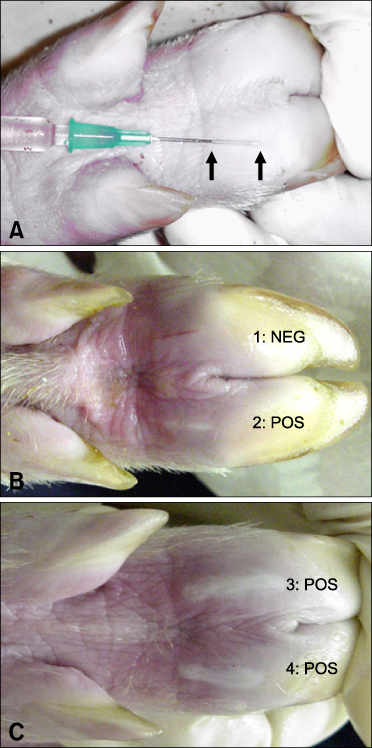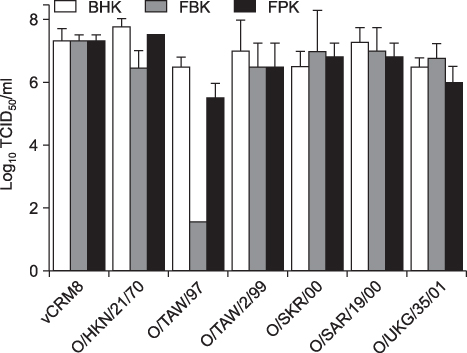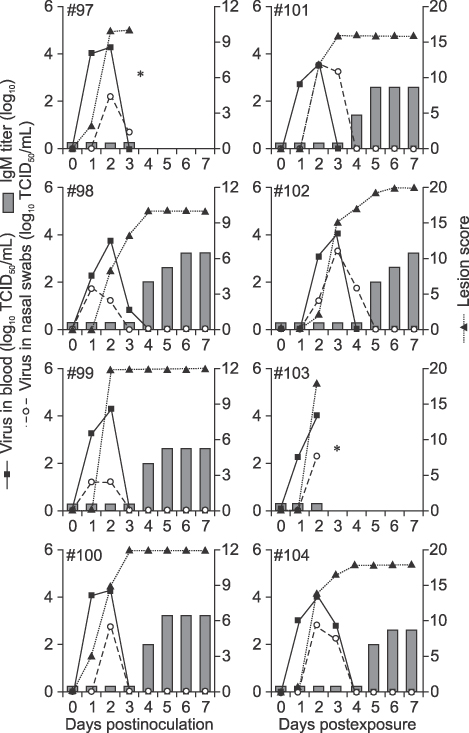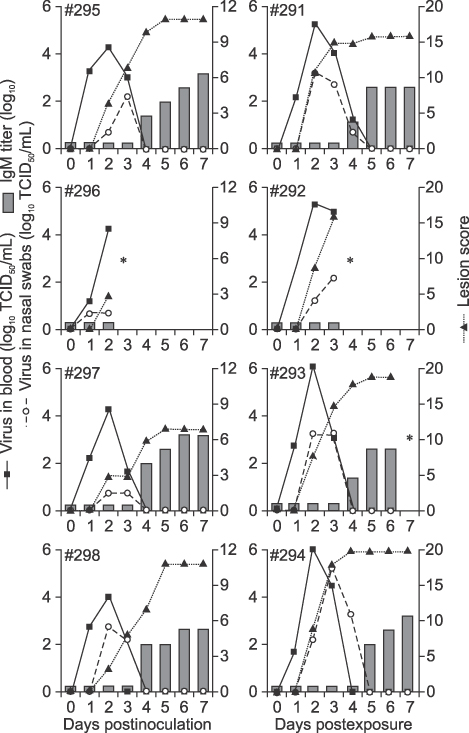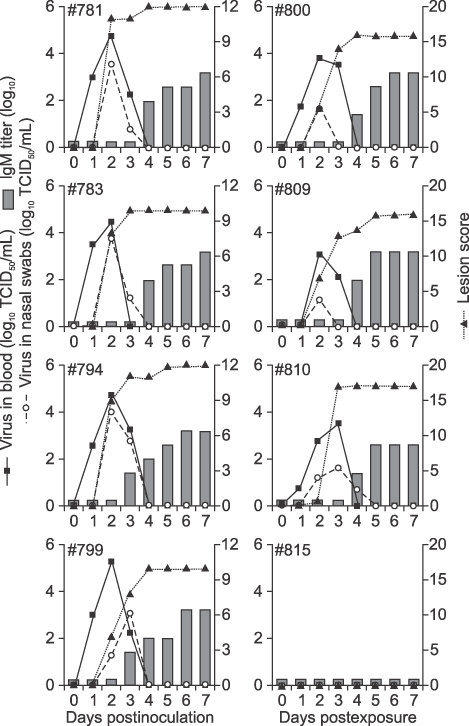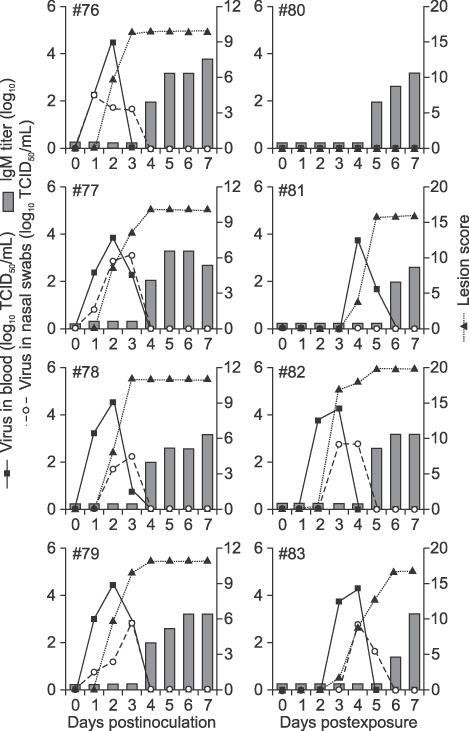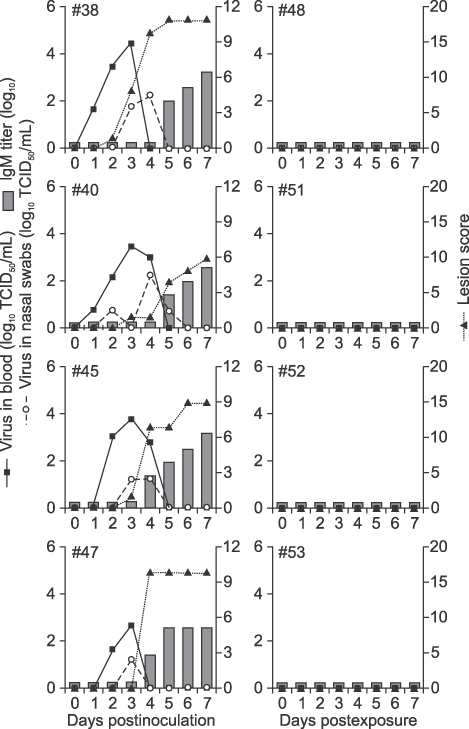J Vet Sci.
2010 Jun;11(2):133-142. 10.4142/jvs.2010.11.2.133.
Evaluation of infectivity and transmission of different Asian foot-and-mouth disease viruses in swine
- Affiliations
-
- 1Plum Island Animal Disease Center, North Atlantic Area, Agricultural Research Service, United States Department of Agriculture, PO Box 848, Greenport, NY 11944-0848, USA. juan.pacheco@ars.usda.gov
- 2Microbial Molecular Biology, Novartis Vaccines and Diagnostics, 350 Massachusetts Avenue, Cambridge, MA 02139, USA.
- KMID: 1110860
- DOI: http://doi.org/10.4142/jvs.2010.11.2.133
Abstract
- Most isolates of foot-and-mouth disease virus (FMDV) display a broad host range. Since the late 1990s, the genetic lineage of PanAsia topotype FMDV serotype O has caused epidemics in the Far East, Africa, the United Kingdom, France, the Netherlands, and numerous other countries throughout Europe and Asia. In contrast, there are several FMDV isolates that exhibit a more restricted host range. A Cathay topotype isolate of FMDV serotype O from the 1997 epizootic in Taiwan (O/TAW/97) demonstrated restricted host specificity, only infecting swine. Methods used to evaluate infectivity and pathogenicity of FMDV isolates in cattle are well-documented, but there has been less progress studying transmission and pathogenicity of FMDV isolates in pigs. In previous studies designed to examine pathogenicity, various chimeric viruses derived from O/TAW/97 were intradermally inoculated in the heel bulb of pigs. Subsequent quantitative scoring of disease and evaluation of virus released into nasal secretions and blood was assessed. Here we prove the usefulness of this method in direct and contact inoculated pigs to evaluate infectivity, pathogenicity and transmission of different Asian FMDV isolates. Virus strains within the Cathay topotype were highly virulent in swine producing a synchronous disease in inoculated animals and were efficiently spread to in-contact naive pigs, while virus strains from the PanAsia topotype displayed more heterogeneous properties.
Keyword
MeSH Terms
Figure
Reference
-
1. Alexandersen S, Brotherhood I, Donaldson AI. Natural aerosol transmission of foot-and-mouth disease virus to pigs: minimal infectious dose for strain O1 Lausanne. Epidemiol Infect. 2002. 128:301–312.
Article2. Alexandersen S, Donaldson AI. Further studies to quantify the dose of natural aerosols of foot-and-mouth disease virus for pigs. Epidemiol Infect. 2002. 128:313–323.
Article3. Alexandersen S, Zhang Z, Donaldson AI, Garland AJ. The pathogenesis and diagnosis of foot-and-mouth disease. J Comp Pathol. 2003. 129:1–36.
Article4. Almeida MR, Rieder E, Chinsangaram J, Ward G, Beard C, Grubman MJ, Mason PW. Construction and evaluation of an attenuated vaccine for foot-and-mouth disease: difficulty adapting the leader proteinase-deleted strategy to the serotype O1 virus. Virus Res. 1998. 55:49–60.
Article5. Beard CW, Mason PW. Genetic determinants of altered virulence of Taiwanese foot-and-mouth disease virus. J Virol. 2000. 74:987–991.
Article6. Burrows R. The infectivity assay of foot-and-mouth disease virus in pigs. J Hyg (Lond). 1966. 64:419–429.
Article7. Chen X, Feng Q, Wu Z, Liu Y, Huang K, Shi R, Chen S, Lu W, Ding M, Collins RA, Fung YW, Lau LT, Yu AC, Chen J. RNA-dependent RNA polymerase gene sequence from foot-and-mouth disease virus in Hong Kong. Biochem Biophys Res Commun. 2003. 308:899–905.
Article8. de Castro MP. Behaviour of the foot-and-mouth disease virus in cell cultures: Susceptibility of the IB-RS-2 cell line. Arq Inst Biol (Sao Paulo). 1964. 31:63–78.9. Donaldson AI, Sellers RF. Transmission of FMD by people. Vet Rec. 2003. 153:279–280.10. Dunn CS, Donaldson AI. Natural adaption to pigs of a Taiwanese isolate of foot-and-mouth disease virus. Vet Rec. 1997. 141:174–175.
Article11. Feng Q, Chen X, Ma O, Liu Y, Ding M, Collins RA, Ko LS, Xing J, Lau LT, Yu AC, Chen J. Serotype and VP1 gene sequence of a foot-and-mouth disease virus from Hong Kong (2002). Biochem Biophys Res Commun. 2003. 302:715–721.
Article12. Ferguson NM, Donnelly CA, Anderson RM. Transmission intensity and impact of control policies on the foot and mouth epidemic in Great Britain. Nature. 2001. 413:542–548.
Article13. Freshney RI. Culture of Animal Cells: A Manual of Basic Technique. 1987. New York: Liss;144.14. George VG, Hierholzer JC, Ades EW. Mahy BWJ, Kangro HO, editors. Cell culture. Virology Methods Manual. 1996. London: Academic Press;3–23.
Article15. Gulbahar MY, Davis WC, Guvenc T, Yarim M, Parlak U, Kabak YB. Myocarditis associated with foot-and-mouth disease virus type O in lambs. Vet Pathol. 2007. 44:589–599.
Article16. Henderson WM. The Quantitative Study of Foot-and-Mouth Disease Virus. Report Series of Agricultural Research Council. No. 8. 1949. Her Majesty's Stationery Office: London;1–50.17. Henderson WM. A comparison of different routes of inoculation of cattle for detection of the virus of foot-andmouth disease. J Hyg (Lond). 1952. 50:182–194.
Article18. Hierholzer JC, Killington RA. Mahy BW, Kangro HO, editors. Virus isolation and quantitation. Virology Methods Manual. 1996. London: Academic Press;25–46.
Article19. House C, House JA. Evaluation of techniques to demonstrate foot-and-mouth disease virus in bovine tongue epithelium: comparison of the sensitivity of cattle, mice, primary cell cultures, cryopreserved cell cultures and established cell lines. Vet Microbiol. 1989. 20:99–109.
Article20. Huang CC, Lin YL, Huang TS, Tu WJ, Lee SH, Jong MH, Lin SY. Molecular characterization of foot-and-mouth disease virus isolated from ruminants in Taiwan in 1999-2000. Vet Microbiol. 2001. 81:193–205.
Article21. Knowles NJ, Davies PR, Henry T, O'Donnell V, Pacheco JM, Mason PW. Emergence in Asia of foot-and-mouth disease viruses with altered host range: characterization of alterations in the 3A protein. J Virol. 2001. 75:1551–1556.
Article22. Knowles NJ, Samuel AR. Molecular epidemiology of foot-and-mouth disease virus. Virus Res. 2003. 91:65–80.
Article23. Knowles NJ, Samuel AR, Davies PR, Kitching RP, Donaldson AI. Outbreak of foot-and-mouth disease virus serotype O in the UK caused by a pandemic strain. Vet Rec. 2001. 148:258–259.24. Knowles NJ, Samuel AR, Davies PR, Midgley RJ, Valarcher JF. Pandemic strain of foot-and-mouth disease virus serotype O. Emerg Infect Dis. 2005. 11:1887–1893.
Article25. Malirat V, de Barros JJ, Bergmann IE, Campos Rde M, Neitzert E, da Costa EV, da Silva EE, Falczuk AJ, Pinheiro DS, de Vergara N, Cirvera JL, Maradei E, Di Landro R. Phylogenetic analysis of foot-and-mouth disease virus type O re-emerging in free areas of South America. Virus Res. 2007. 124:22–28.
Article26. Mason PW, Pacheco JM, Zhao QZ, Knowles NJ. Comparisons of the complete genomes of Asian, African and European isolates of a recent foot-and-mouth disease virus type O pandemic strain (PanAsia). J Gen Virol. 2003. 84:1583–1593.
Article27. Mattion N, König G, Seki C, Smitsaart E, Maradei E, Robiolo B, Duffy S, León E, Piccone M, Sadir A, Bottini R, Cosentino B, Falczuk A, Maresca R, Periolo O, Bellinzoni R, Espinoza A, Torre JL, Palma EL. Reintroduction of foot-and-mouth disease in Argentina: characterisation of the isolates and development of tools for the control and eradication of the disease. Vaccine. 2004. 22:4149–4162.
Article28. Mingqiu Z, Qingli S, Jinding C, Lijun C, Yanfang X. Sequence analysis of the protein-coding regions of foot-and-mouth disease virus O/HK/2001. Vet Microbiol. 2008. 130:238–246.
Article29. O'Donnell VK, Pacheco JM, Henry TM, Mason PW. Subcellular distribution of the foot-and-mouth disease virus 3A protein in cells infected with viruses encoding wild-type and bovine-attenuated forms of 3A. Virology. 2001. 287:151–162.30. Oem JK, Lee KN, Cho IS, Kye SJ, Park JH, Joo YS. Comparison and analysis of the complete nucleotide sequence of foot-and-mouth disease viruses from animals in Korea and other PanAsia strains. Virus Genes. 2004. 29:63–71.
Article31. Oem JK, Lee KN, Cho IS, Kye SJ, Park JY, Park JH, Kim YJ, Joo YS, Song HJ. Identification and antigenic site analysis of foot-and-mouth disease virus from pigs and cattle in Korea. J Vet Sci. 2005. 6:117–124.
Article32. OIE. Manual of Standards for Diagnostic Tests and Vaccines. Chapter 2.1.1. Foot and Mouth Disease. 2000. Paris: OIE;77–92.33. Pacheco JM, Henry TM, O'Donnell VK, Gregory JB, Mason PW. Role of nonstructural proteins 3A and 3B in host range and pathogenicity of foot-and-mouth disease virus. J Virol. 2003. 77:13017–13027.
Article34. Reed LJ, Muench H. A simple method of estimating fifty percent endpoints. Am J Hyg. 1938. 27:493–497.35. Sa-Carvalho D, Rieder E, Baxt B, Rodarte R, Tanuri A, Mason PW. Tissue culture adaptation of foot-and-mouth disease virus selects viruses that bind to heparin and are attenuated in cattle. J Virol. 1997. 71:5115–5123.
Article36. Sakamoto K, Kanno T, Yamakawa M, Yoshida K, Yamazoe R, Murakami Y. Isolation of foot-and-mouth disease virus from Japanese black cattle in Miyazaki Prefecture, Japan, 2000. J Vet Med Sci. 2002. 64:91–94.
Article37. Samuel AR, Knowles NJ. Foot-and-mouth disease type O viruses exhibit genetically and geographically distinct evolutionary lineages (topotypes). J Gen Virol. 2001. 82:609–621.
Article38. Sellers RF. Quantitative aspects of the spread of foot and mouth disease. Vet Bull. 1971. 41:431–439.39. Yang PC, Chu RM, Chung WB, Sung HT. Epidemiological characteristics and financial costs of the 1997 foot-and-mouth disease epidemic in Taiwan. Vet Rec. 1999. 145:731–734.
Article
- Full Text Links
- Actions
-
Cited
- CITED
-
- Close
- Share
- Similar articles
-
- How far can African swine fever spread?
- Requirements for improved vaccines against foot-and-mouth disease epidemics
- Detection of Pathogenic Viruses in the Atmosphere during Asian Dust Events in Incheon City
- Isolation of Echovirus Serotype 25 from Patient with Hand , Foot and Mouth Disease in Pusan , 1998
- Foot and Mouth Disease : Etiology, Epidemiology and Control Measures

